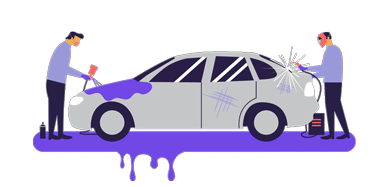Oxidation and Haze Removal
Oxidation and haze removal is a crucial step in auto detailing that restores a vehicle’s paint finish by eliminating the effects of weathering, exposure to UV rays, and environmental contaminants. Oxidation appears as a dull, chalky appearance on the paint, and haze is typically caused by incomplete removal of polish or compound residue. Here’s a step-by-step guide on how to effectively remove oxidation and haze from your car’s paint:
Materials Needed:
- Dual-action or rotary polisher
- Polishing pads (cutting, polishing, and finishing)
- Compounds and polishes (varying abrasiveness)
- Microfiber towels
- Paint thickness gauge (optional but recommended)
- Painter’s tape
- Isopropyl alcohol (for panel wipe)
- Car wax or paint sealant (for protection)
Step-by-Step Guide:
- Wash and Decontaminate: Start with a thorough car wash to remove loose dirt and contaminants. Decontaminate the paint using a clay bar if necessary to ensure a clean surface.
- Assess the Damage: Carefully inspect the paint to identify the extent of oxidation and haze. Determine if oxidation is widespread or localized. Oxidation often appears as a chalky, dull surface, while haze may be seen as a cloudy or hazy appearance.
- Mask Off Trim: Use painter’s tape to mask off any trim, plastic, or rubber surfaces near the area you’ll be working on. This prevents accidentally damaging these areas with the polisher.
- Test the Paint Thickness (Optional): If you have a paint thickness gauge, measure the paint’s thickness on various panels. This helps ensure that you have enough clear coat to safely correct the oxidation without risking paint damage.
- Select the Right Products: Choose a cutting compound that is specifically designed for oxidation removal. You may also need a finer polish for later stages of the process.
- Apply Compound: Apply a small amount of cutting compound to the cutting pad on your polishing machine. Spread it evenly over the oxidized or hazy surface.
- Polish the Paint: Turn on your polisher at a low speed to spread the product and then gradually increase the speed. Work in small sections, applying light to moderate pressure. Use overlapping passes, and be patient; it may take several passes to remove the oxidation and haze.
- Check Your Progress: Periodically stop and wipe the product residue away with a microfiber towel to assess your progress. If oxidation and haze are still visible, continue polishing until they are removed.
- Final Polishing: Switch to a finer polish and a finishing pad to remove any remaining haze or micro-marring left by the previous step. This step enhances gloss and clarity.
- Panel Wipe: Clean the surface with isopropyl alcohol to remove any remaining residue and oils.
- Protection: Apply a wax, sealant, or ceramic coating to protect the newly corrected finish. This step helps maintain the paint’s appearance and prevents future oxidation.
- Inspect Your Work: After completing the process on the entire vehicle, inspect your work to ensure that all oxidation and haze have been effectively removed.
Removing oxidation and haze can significantly improve the appearance of your car’s paint and protect it from further deterioration. If you’re unsure about the process or if the oxidation is severe, it’s advisable to consult with a professional detailer to avoid potential paint damage.

 Please Wait...
Please Wait...